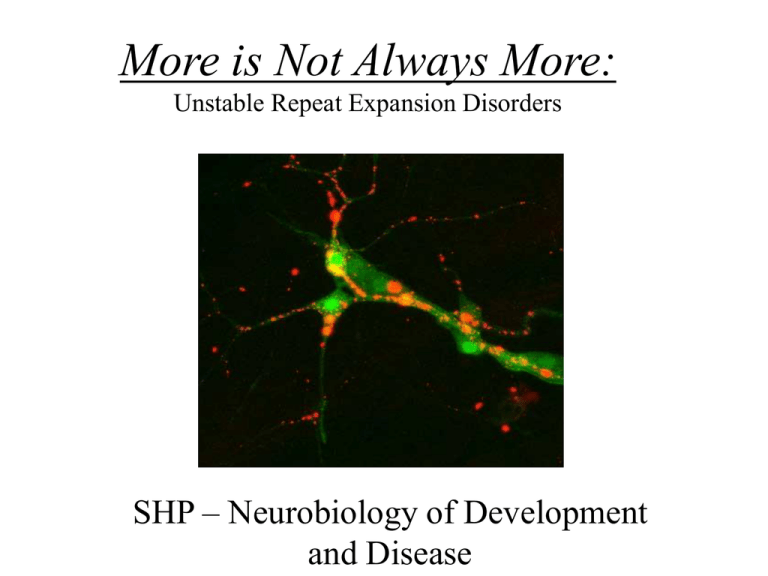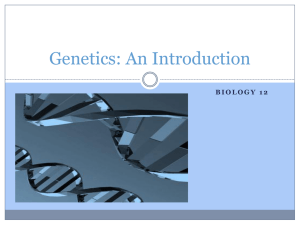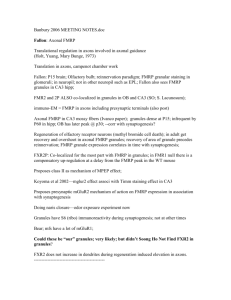Document
advertisement

More is Not Always More: Unstable Repeat Expansion Disorders SHP – Neurobiology of Development and Disease Two way trinucleotide repeats can effect gene function • occur in non-coding DNA (ie promoters) transcriptional silencing, loss of function • occur in coding sequence lead to perturbation of gene function, usually gain of function Di Prospero and Fischbeck, Nature Reviews Genetics 2005 Gatchel and Zoghbi, Nature Reviews Genetics 2005 Gatchel and Zoghbi, Nature Reviews Genetics 2005 Huntington Disease: the prototypical unstable repeat disorder • • • • • Effect about 5 in 100,000 men and women Linked to a large protein called huntington Highly penetrant autosomal dominant disorder From diagnosis to mortality is ~10-25yrs. Symptoms: – Heritability – Chorea – Cognitive impairment, irritability, antisocial behavior – Death in 15-20 years – Degeneration of the caudate nucleus Spinocerebellar Ataxia (SCA1-16) • As name suggests, patients experience lack of motor coordination. • Multigenic disorder, each with their own distinctive loss of neuronal subtypes and brain areas, durations, and symptoms. • Most seem to have a substantial degeneration of the cerebellum. • Autosomal dominant disorder. Polyglutamine Tracts • • • • • Normally contains 19-22 consecutive glutamines Gene is manifest with 48 or more repeats of the codon with more repeats causing earlier onset of the disease PolyQ tract expands in successive generations (particular in males) PolyQ tracts are thought to be toxic - fusing these proteins to innocuous proteins makes those proteins toxic (although the normal protein is required for normal pathology) Cells expressing proteins with expanded repeats contain aggregates of protein within the cell body and cytoplasm. Consequences of Glutamine Expansion • • • • • Expansion of polyQ tract can enhance or alter protein-protein interactions that normally occur Protein accumulates into inclusion bodies which may incorporate chaperones (hsp70) and ubiquitin/proteosome pathway components Huntingtin can be cleaved by proteases including caspases and caspases into more toxic peptide fragments. Mutant protein may interact with or sequester transcriptional regulators. Interfere with other cellular processes including RNA metabolism, Ca2++ equilibria, inhibiting mitochondrial function and metabolism. Gatchel and Zoghbi, Nature Reviews Genetics 2005 Di Prospero and Fischbeck, Nature Reviews Genetics 2005 Potential Therapeutic Strategies: Diseases by Loss of Protein Function • Include expanding repeats: CGG, GCC, GAA, CTG, and CAG • Expansion of these C/G rich repeats results in methylation of CpG stretches and transcriptional silencing. Fragile X Syndrome • A leading cause of inherited mental retardation • X-linked • Caused by expansion of CGG repeats in the 5’-UTR of the FMR1 (FMRP is protein product) gene. • 60-200 repeats are innocuous but over 200 are associated with the syndrome. FMRP is Involved in RNA Processing and Translation • FMRP associates with many components of the RNA processing machinery. • Mutations cause problems with association of polyribosomes • Loss of FMRP likely destabilizes assembly of these complexes Gatchel and Zoghbi, Nature Reviews Genetics 2005 Fragile X Neurons have Longer, Immature Dendritic Spines • FMRP seems to be involved in dendritic development. Fragile X patients contain • Glutamate overstimulation upregulates the expression of FMRP, so mutant protein seems to sensitize against excitoxicity responses. Gatchel and Zoghbi, Nature Reviews Genetics 2005 Disease of Metabolism: Friedreich Ataxia • • • • Autosomal recessive congenital disorder The most commonly inherited ataxia Caused by a mutation in the gene frataxin Many parallels to muscular dystrophy although with degeneration of the nervous system • Symptoms: – Muscle weakness in the limbs – Ataxia – Vision impairment – Hearing loss – Slurred speech – Scoliosis – Heart conditions – Sugar intolerance Frataxin (FXN) • Frataxin associates with the inner mitochondrial membrane • Expansions of repeats in the FXN prevent elongation of the transcript. • Deletion of the gene results in accumulation of iron in mitochondria, which causes accumulation of free radicals oxidative damage • Decrease in production of proteins with iron-sulfur clusters. Gatchel and Zoghbi, Nature Reviews Genetics 2005 Strategies for Treatment of Friedreich Ataxia • Enhancing Assembly/Production of Fe/S cluster proteins • Protection against oxidative damage by free radicals in the cell. • Free radicals may diminished by potentiating the function of superoxide dismutase (SOD). • Chelation of Fe ions in the mitochondria selectively • Acetylation of histones to activate gene transcription or prevent silencing. Di Prospero and Fischbeck, Nature Reviews Genetics 2005 Prevention of Silencing at the Transcriptional Level Might Diminish Pathological Symptoms Di Prospero and Fischbeck, Nature Reviews Genetics 2005 Tracking Microscope Used to Visualize Huntingin Aggregation and Cell Death Many Neurons Die without Forming Inclusion Bodies Levels of Diffuse mutant Htt Protein Protein Predict Neuronal Death Inclusion Body Formation is Protective Against Htt-induced Death







